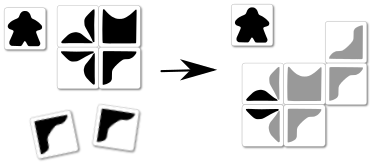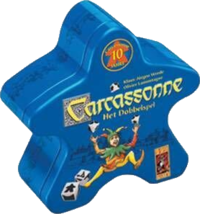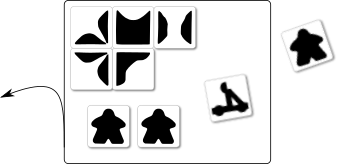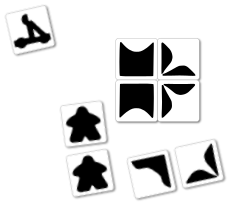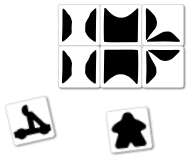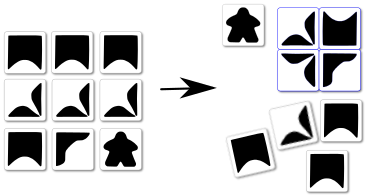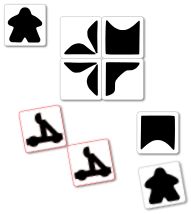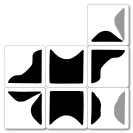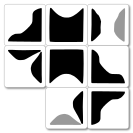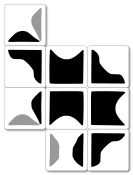Het Dobbelspel
Algemene informatie en opmerkingen
Dit is het officiële dobbelspel van Carcassonne. Een spel voor 2-5 spelers dat als onderdeel van het 10-jarig jubileum van Carcassonne in 2011 uitgegeven werd door Hans im Glück. Ontworpen door Olivier Lamontagne en Klaus-Jürgen Wrede.
Speelmateriaal
Het spel zit in een metalen doos in de vorm van een meeple en bevat:
- 9 Carcassonne-dobbelstenen met de volgende zijden:
- 4 stadsdelen
- 1 ridder
- 1 katapult
- 1 scoreblok
- 1 potlood
Overzicht
Bij het Carcassonne dobbelspel proberen de spelers door handig te dobbelen zo groot mogelijke steden te bouwen - hoe groter, hoe beter.
Spelregels
Spelverloop
De spelers werpen om de beurt de dobbelstenen. De spelers kiezen een startspeler die zal beginnen en neemt alle 9 dobbelstenen. Tijdens zijn beurt werpt hij de dobbelstenen maximaal 3 keer en telt vervolgens de punten voor het resultaat (zie de sectie puntentelling). Dan geeft hij de dobbelstenen aan zijn linker buurman, die het spel voortzet.
De speler werpt voor de eerste worp alle dobbelstenen die hij voor zich heeft liggen. Als hij 1 of meer katapulten gooit, dan geeft hij die dobbelstenen direct aan de speler links van hem (hij mag de katapulten niet opnieuw werpen of er deze worp punten voor krijgen).
Werpt de speler ridders of stadsdelen dan mag hij die naar keuze verzamelen of opnieuw werpen. Als de speler een stadsdeel verzamelt, dan moet hij daar onmiddellijk een stad mee bouwen. De speler mag eenmaal gebouwde stadsdelen niet opnieuw bouwen. Verzamelde ridders mogen niet opnieuw geworpen worden.
Als een speler 3 of meer ridders verzamelt, mag hij ervoor kiezen deze beurt geen punten te tellen om zijn punten in de volgende beurt te verdubbelen. Hij houdt 1 ridder en geeft alle andere dobbelstenen aan zijn linkerbuurman. Bij zijn volgende beurt, voegt hij de dobbelsteen met de ridder toe aan de dobbelstenen die hij doorgegeven krijgt en werpt die. Elke speler kan dus een ridder hebben, waardoor de andere spelers er minder over houden.
Steden bouwen
De speler probeert een zo groot mogelijke stad te bouwen met de dobbelstenen die hij geworpen heeft. Bij de puntentelling, telt hij het aantal dobbelstenen waaruit zijn grootste stad bestaat.
City building rules
- The black parts are the city segments.
- Black parts are played next to black parts and white parts next to white parts.
- Once a die is used to build, it may not be re-rolled.
Scoring
After a player has rolled 3 times or chooses not to roll again, he may score his turn. The rules for scoring are:
- Only the dice of the largest closed city are scored (if the player did not build a closed city, he scores no points).
- If the player had a knight at the beginning of his turn, he scores double the points.
- The points are recording on the score pad.
- The points are scored as follows:
- 3 dice = 1 point
- 4 dice = 3 points
- 5 dice = 6 points
- 6 dice = 10 points
- 7 dice = 15 points
- 8 dice = 21 points
- 9 dice = 28 points
Game end
As soon as a player has scored 42 total points, the game ends and that player is the winner.
Special case: if a player rolls 9 catapults during his turn, he wins immediately, regardless of the points he scored so far in the game.
Additional information
This section extends the basic information provided in the rules.
Detailed turn example
This example provides additional details about the impossibility of moving the dice placed as city or re-rolling knights.
